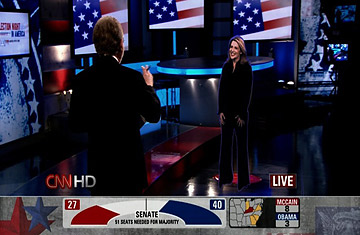
CNN anchor Wolf Blitzer is in New York talking to CNN reporter Jessica Yellin in Chicago, who is projected as a three-dimensional hologram, during election night coverage November 4, 2008, making it appear as if she is in the Manhattan studio with Blitzer.
As television news stunts go, CNN's debut of a "hologram" reporter during its election-night coverage was one of the most talked about — and yes, bizarre — of the past year. "Hi, Wolf!" chirped beaming CNN correspondent Jessica Yellin, who was in Chicago at the victory rally for President-elect Barack Obama yet miraculously appeared on TV to be standing before anchor Wolf Blitzer in the CNN newsroom, waving — and surrounded by a fuzzy white line. In the studio, Blitzer was talking to empty space, although he could see Yellin on a nearby monitor. "We beamed you in here into the CNN election center," said Blitzer, who received 242 viewer e-mails about the stunt, 80% of which "expressed how 'cool' it was," according to a CNN spokeswoman. will.i.am, musician and creator of the Yes We Can viral video, also made a brief appearance in digitized form to be interviewed by Anderson Cooper. (See pictures from the historic Election Day.)
CNN Washington bureau chief David Bohrman admits the "hologram" didn't have a great deal of journalistic importance other than that it allowed Blitzer to talk to Yellin without the commotion and noise of the 240,000-strong crowd gathered in Grant Park in Chicago. "I'm not sure the point was terribly deep," he says. "But I do think that if you look 20 years into the future, television will do something like this routinely."
This may be true. YouTube clips of Yellin and will.i.am have been viewed hundreds of thousands of times online.
But to howls of outrage from science-fiction geeks and engineering purists worldwide, CNN acknowledges that its "hologram" wasn't a hologram at all. The feat was accomplished with a 3-D green-screen digital-composite technique that's been in use for years. Some 40 high-definition cameras arranged in a circle filmed Yellin at the same time against a 360-degree green background; the images were overlaid to make Yellin appear three-dimensional, and the reporter was then digitally pasted into the frame next to Blitzer. Specialized software was used to make sure her image lined up with the movement and angles of the cameras in CNN's election-center studio. The technology (and money) to create freestanding, three-dimensional, real-time holograms — in which Yellin would have looked to Blitzer as if she were standing right next to him — is still at least a decade away.
Holography was invented in 1947 by Dennis Gabor, a Hungarian scientist working in London who discovered that reflected light could be captured and reconstructed to create the illusion of three-dimensional images. (He won the 1971 Nobel Prize for Physics for the discovery.) Gabor, however, lacked the technology to perfect holograms; double images sometimes appeared at once and were not viewable. In the 1960s, Emmett Leith added lasers to the equation and rendered the first stable holograms — which included a toy train that astounded other scientists when they saw it.
At a 1965 electronics conference, scientists showed colleagues a "holographic moving picture," but the stars of that film were limited to steel balls and slow-moving gears. Still, reality is rarely a limit to a marketer's imagination. In succeeding years, futuristic-seeming holograms became a gimmick. Sports Illustrated put a 3-D Michael Jordan on its cover in 1991, and the U.S. Postal Service issued its first hologram stamp in 1989. Both quickly became collector's items. Homemade holograms are difficult to create, requiring lasers and holographic plates or film, which has made them effective counterfeit deterrents used on credit cards and identification documents. But movie-quality, 3-D holography — think Princess Leia in Star Wars — is a whole other beast. For one thing, researchers need to find a way to create moving, three-dimensional images of human beings without burning them with lasers. Researchers at the University of Arizona are developing technology for 3-D video but predict that a usable, commercial product won't be available for at least 10 years. Many other scientists say it could take much longer.
As for Blitzer and his virtual correspondent, most viewers probably don't care whether what they saw was a real hologram or a fake one — which means CNN probably doesn't either. Still, promises Bohrman, "when and if technology allows us to do this for real, we really will."
